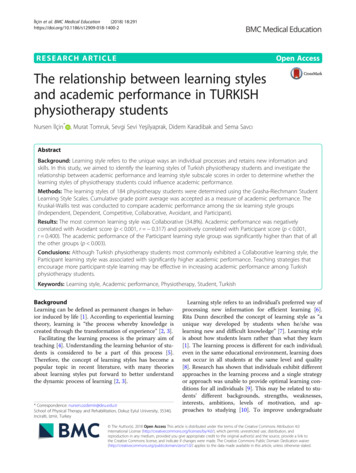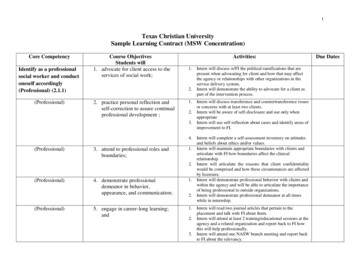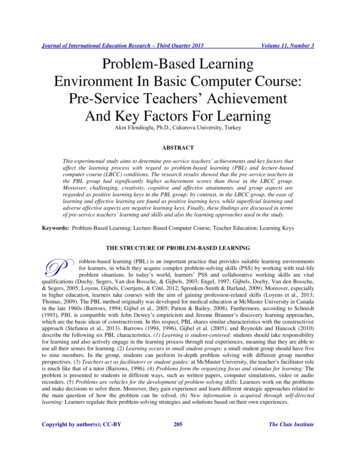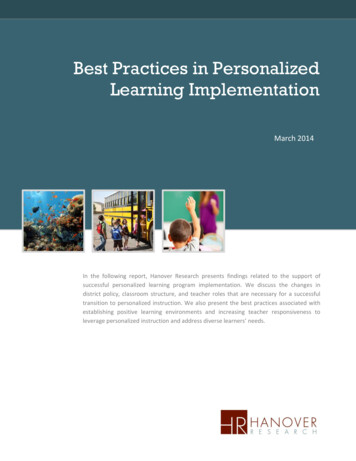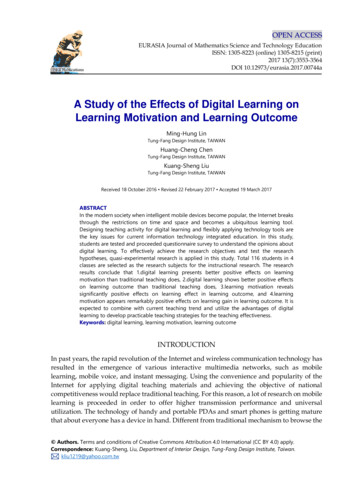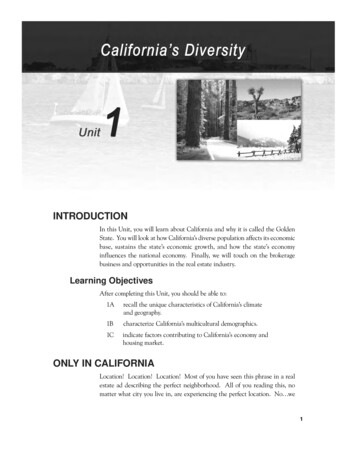
Transcription
INTRODUCTIONIn this Unit, you will learn about California and why it is called the GoldenState. You will look at how California’s diverse population affects its economicbase, sustains the state’s economic growth, and how the state’s economyinfluences the national economy. Finally, we will touch on the brokeragebusiness and opportunities in the real estate industry.Learning ObjectivesAfter completing this Unit, you should be able to:1Arecall the unique characteristics of California’s climateand geography.1Bcharacterize California’s multicultural demographics.1Cindicate factors contributing to California’s economy andhousing market.ONLY IN CALIFORNIALocation! Location! Location! Most of you have seen this phrase in a realestate ad describing the perfect neighborhood. All of you reading this, nomatter what city you live in, are experiencing the perfect location. No we1
2California Real Estate Principlesare not referring to your specific street, town or county we are talking aboutCalifornia. California has everything, and usually it is the best! Whoeversaid, “Less is more” just never lived in California.California’s natural and man-made wonders can only be described withsuperlatives. California’s economy is so large that it actually competes withcountries—not just states. Additionally, it is the first state to ever reach atrillion-dollar economy in gross state product. At over 38 million people,California is the most culturally diverse and the most populous state in thecountry, and has been since 1962. In fact, one out of every eight United Statesresidents lives in California. California is called The Golden State. Some sayit is due to its long association with gold mining made famous by the GoldRush. Others point to the golden grasses that cover our hills in the summerand fall, or the fields of golden poppies that bloom in the springtime. Youmight call California golden because of our fabulous, golden sunshine andwarm climate. In any event, gold has been intertwined with the history anddevelopment of California.Climate and GeographyWhere but California could you surf in the morning, play 18 holes of golf,and then enjoy a torch-lit night ski run—all in the same day? California is abeautiful place, blessed with phenomenal natural beauty and a climate freefrom hurricanes, tornadoes, and blizzards. We definitely enjoy a relativelymild climate.ClimateOur basic climate is calledMediterranean, characterizedby general sun and warmthwith rain mainly in the winter.Of course, there are variationsbased on the distance fromthe ocean and the elevation.Average rainfall varies from80 inches in Del NorteCounty (north coast) to as lowas 3 inches in Imperial County(desert).California has a relatively mild climate
Unit 1 California’s Diversity 3We have five main zones: coastal, desert, foothill, valley, and mountain.Coastal climate is characterizedby mild temperatures with minorannual variations. Most of thestate’s population lives alongthe coast.Desert climate is characterizedby high summer temperatures,extremely low humidity, andvery little rainfall.Valley climate is characterizedby high temperatures and lowhumidity in the summer andlow temperature and highhumidity in the winter. Boththe Sacramento and San JoaquinValleys have this weatherpattern.
4California Real Estate PrinciplesFoothill climate (1,000 to 3,000feet in elevation) is similar to thevalley regions but with more rainand less fog.Mountain climate is the only areathat gets heavy snow in the winter.Winters are very cold and summersare bright and sunny.GeographyCalifornia is the third largest state in land area (158,693 square miles) with1,264 miles of coastline and an average width of 175 miles. We have everythinghere: beautiful beaches, deserts, valleys, foothills, towering mountains, andeven a delta with levees.There are still three active volcanoes in California. In the Cascade MountainRange are Mt. Lassen (elevation 10,457 feet) and Mt. Shasta (elevation 14,162feet). Mt. Mammoth (elevation 11,000 feet) is located in the Sierra NevadaMountain Range.CALIFORNIA—THE PEOPLE MAGNETCalifornia, with its mild climate and seemingly unending opportunities,continues to draw immigrants today just as it did 150 years ago. We shouldn’tbe surprised. A recent Harris Poll conducted online among a nationwide
Unit 1 California’s Diversity 5cross section of adults, showed that Americans would like to live here thanin any other state. They were asked, “If you could live in any state in thecountry, except the state you live in now, what state would you choose to livein?” California was the first choice with Florida second and Hawaii third.Finding CaliforniaCalifornia was already inhabited by Native Americans in villages and tribeswhen early explorers touched our coastline and made new claims for foreigncountries. Portuguese-born Juan Rodriguez Cabrillo explored the Californiacoastline from San Diego to Santa Barbara and claimed it for Spain. SirFrancis Drake landed north of San Francisco Bay and claimed the territoryfor England. The Russians established Fort Ross, a trading post near BodegaBay, and claimed the territory north of San Francisco for Russia.A few hardy settlers in covered wagons took the perilous trek across thedeserts to reach the promise of a better future. But, when gold was discoveredin Sutter’s Mill in 1848, the Forty-Niners flocked here with strike-it-richdreams. When Southern Pacific Railroad finally extended its rail systeminto Los Angeles, it hired real estate developers to tout Southern Californiaas a Mediterranean-like paradise. They were very successful because over12,000 eager tourists and settlers arrived by railroad each month. In just20 short years, the population in Los Angeles grew from 11,000 in 1880 tomore than 100,000 by 1900. During World War II, the government spentbillions of dollars each year in government contracts to build liberty ships andthousands of warplanes. Lured by the promise of work, more than 700,000workers had come to California by 1943. They located by the defense plantsin Los Angeles, Santa Monica, Burbank, Long Beach, El Segundo, and SanDiego.After the war, the California economy continued to boom drawing yet morepeople. In 1962, California, with a population of more than 17 million,officially surpassed that of New York. Since then people have come here fromall parts of the world, drawn to our wonderful climate, stunning landscapes,and economic opportunities.As of the 2010 U.S. Census, California had an estimated population of 38million, which is more than 12% of the U.S. population. In addition, LosAngeles County was the nation’s most populous county, with 9.8 millionresidents.
6California Real Estate PrinciplesThis large population corridor interconnected by economic activity,transportation, and communication linkages creates a megalopolis. Amegalopolis is a large, densely populated metropolitan area consisting of anumber of major urban areas and smaller surrounding cities. The SouthernCalifornia megalopolis stretches from Santa Barbara to the Mexican border,and is centered around the city of Los Angeles. It is the largest populationcenter and industrial center in the western United States, and the secondlargest in the nation.Multicultural CaliforniaBecause people everywhere have viewed California as a land of opportunity,California has become one of the most ethnically diverse regions of the world.Nearly one-half of Californians speak a language other than English at home,a proportion far higher than in any other state.Our population reflects virtually every area of the globe, as new arrivalscontinue to stake their claims to the California dream. Victorian homes inEureka, New England-style cottages in Mendocino, houseboats in Sausalito,and Spanish-style homes in Southern California remind us of the diversity ofour grandparents.The largest group (more thanhalf of the population) is madeup of people whose ancestorscame from the British Isles;European countries such asGermany, France, Poland,and Italy; and Scandinaviancountries such as Norway andSweden. More than 1/3 ofCalifornians have ethnic rootsin Latin America. The Golden State has more people who speak Spanishthan any other state.About 14% of the state’s population is Asian. The Tien Hau Temple in SanFrancisco is the oldest Chinese temple in the United States. The Bok KaiTaoist temple in Marysville is over 121 years old. African Americans are about7% of the state’s population. Although Native Americans make up less thanone percent of the total population, California has about 250 Native Americantribes, more than exist in any other state.
Unit 1 California’s Diversity 7One of the best ways to learn about California’sethnic diversity is to enjoy the many festivalsand celebrations held up and down the state. InFebruary, the annual San Francisco Chinese NewYear Festival and Parade features a huge dancingdragon and brightly lit floats. In early May, MexicanAmericans throughout the state celebrate Cincode Mayo with large fiestas. Native Americantribes gather from across the country to performceremonial dancing, drumming, and singing at theannual Indian Fair held each June in San Diego.Each July, the French Festival in Santa Barbaracelebrates the music,art, dancing, and food of France. The LosAngeles African Marketplace and Cultural Fairecelebrate African culture around the world inlate summer. The Japanese Cultural Bazaar isheld every August in Sacramento and featuresJapanese food, dancing, art, and Taiko drummers.Every July 4th, Americans, regardless of ethnicancestry, join together to celebrate our nation’sbirthday with parades, picnics, and fireworks.CALIFORNIA’S STRONG ECONOMYThe economic system in America, and therefore California, is a mixedcapitalistic system. Capitalism is an economic system in which most of theeconomy’s resources are privately owned and managed. The governmentis asked by its citizens to influence the general economic direction, andto assure reasonable, stable competition. Currently, California has the 7thlargest economy in the world. California generates more than 13% of theUnited States Gross Domestic Product (GDP) and is the nation’s number oneexporting state. California produces more than 1 trillion worth of goodsand services each year.
8California Real Estate PrinciplesCalifornia is home to more than 2.5 million small businesses. If you’ve evereaten at a Denny’s, Carl’s Jr., Taco Bell, A&W, or Bob’s Big Boy, you’ve eatenat a restaurant chain that started in California. Dick and Mac McDonaldopened the first McDonald’s restaurant in San Bernardino, California.The early California economy was basedprimarily on agriculture, mining, anddrilling for oil and gas. Gold and silvermining brought wealth to NorthernCalifornia. The “black gold” of our oilwells brought capital investment andunbridled growth to Southern California.The Golden Era of Hollywood captured the imagination of all Americanswith movie making and star building and brought more wealth into SouthernCalifornia. Northern California experienced a new Gold Rush when computertechnology made the Silicon Valley a “buzz word”around the world.Currently, California’s top industries include:tourism, manufacturing, construction, agriculture,oil and gas production, telecommunications,engineering services, aerospace, and entertainment(including motion pictures, TV, and recording).The state is geared for the future with continuingadvances in microelectronics, biotechnology, andenvironmental technology.The Golden Era of Hollywoodcaptured the imaginationof many Americans.With the opportunity to work in such a diversesociety and consistent economy, no wonderCalifornia has such a strong appeal. Where elseare dreams so welcomed and so often rewarded?California . wheredreams are rewarded.
Unit 1 California’s Diversity 9Economic Firsts1873 - Levi Strauss & Co., the largest clothing manufacturer in theworld, created and patented the world’s first blue jeans.1860 - California’s famous mail courier service, the Pony Express, wasthe first of its kind, connecting California’s communicationsystem with the Midwest.1873 - The world’s first cable car rumbled down the streets of SanFrancisco. Cable cars are still popular today with visitors andresidents.1905 - Eleven-year-old Frank Epperson accidentally inventedPopsicles in San Francisco. He applied for the patent in1923.1908 - The “Sultan’s Power” was the first complete film made in LosAngeles.1927 - Lindbergh’s plane, “The Spirit of St. Louis”, was built in SanDiego.1934 - The first mass-produced commercial aircraft, the DC-2, wasbuilt by McDonnell Douglas in Santa Monica.1935 - A statewide irrigation system was started. Irrigation turnedthe vast land of the Great Central Valley from semi-arid plainsto green croplands. This project is the world’s largest waterproject. Allegedly, according to Susan Sward writing in theSanta Barbara News-Press in March, 1977, “.the astronautswho landed on the moon reported they could see the Californiaproject, the only man-made item they could identify fromthat distance”. Today, California is the leading agriculturaleconomy of the United States.1970 - Security National Bank activated the first automated tellerbank in Los Angeles.1970s - Mountain biking was invented in Mill Valley and first testedon Mount Tamalpais in Marin County.1977 - The Apple II computer was developed in Silicon Valley.
10 California Real Estate PrinciplesThe Importance of Real Estate in the EconomyThe real estate industry is so large that it influences both the state and thenational economies. The major roles that real estate plays in our economyare creating net worth, increasing income flow, creating new jobs, and helpingcontrol appreciation and inflation.Net WorthReal estate in the form of land and improvements makes up a very large portionof the total net worth of the United States as a nation (not to be confusedwith the government). Net worth is the value of all assets minus all liabilities.Income FlowThe circular flow chart of our economy—money is paid for the use of real estateand for the raw materials, labor, capital, and management used in constructionwork of all kinds.The circular flow of the national economy.Major EmployerThe real estate industry (brokerage, construction, management, finance) is amajor employer in this country. It provides employment for a large segment ofthe population, accounting for billions of dollars in national income.
Unit 1 California’s Diversity 11Appreciation and InflationAppreciation is the increase in market value of real estate. Inflation ismeasured as an increase in the general price level of goods and services, or asa decrease in purchasing power of the dollar. As the value of the dollar hasdecreased, passbook savings accounts and other forms of financial savingshave lost their appeal as ways to save and invest for the future. As a result,real estate has become a major means by which people save. Particularly inCalifornia where property appreciated at such an alarmingly fast rate, it wascommon for homeowners to consider their home as money in the bank. Thisis true unless home values depreciate significantly.California Housing MarketThe housing market is shaped mainly by the inventory of available housing,by housing affordability, and by mortgage interest rates. California’s inventoryof housing units is not enough to meet the demand because our populationtypically increases faster than our supply of housing. With a shortage ofhousing, we know there is demand. The next thing to look at is the affordabilityindex. The affordability index shows how many households will be able toafford a median-priced home in California. As the affordability index getslower it means fewer households will be able to buy a home. For example, ifthe affordability index falls to 19, less than one-in-five households will be ableto purchase a median-priced home in California. The higher the affordabilityindex, the more households are able to purchase homes. Finally, we need tolook at current mortgage interest rates. Interest rates determine the amount ofa loan a borrower can get. The higher the interest, the lower the loan amount,and conversely, the lower the interest, the higher the loan amount.Based on this, the best housing market would be created with adequate housinginventory, a high affordability index, and low interest rates.Median Home PricesThe median home price is the price that is middle value of a sample of sales,with one-half of the sales below and one-half of the sales above the medianhome price. It is used by economists to compare home sale prices and measureincreases and decreases. The housing market fluctuates with time and location.However, over the last 25 years, all areas of California have shown increasesin the median home price. Some areas, however, have increased far morethan others.
12 California Real Estate PrinciplesThe California Association of REALTORS (C.A.R.) is a trade associationthat is dedicated to the advancement of professionalism in real estate. C.A.R.tracks the median home sales price for several geographic areas. The followingtable shows some of the areas and the increase in the median home sales price.In spite of short-term fluctuation in home prices, as we can see from thefollowing table, the median price of a single-family home in California continuesto increase.Median Home Prices By CountyCalifornia Counties19832016 92,700 222,980Los Angeles County 118,500 492,350Monterey 112,600 517,370Napa 94,700 629,115Orange 131,450 733,110Riverside 94,900 350,720Sacramento 76,150 313,490San Bernardino 80,400 243,830San Diego 103,100 556,590San Francisco 133,750 1,329,750San Luis Obispo 104,150 543,690Santa Barbara 131,750 695,730Santa Clara 134,000 1,015,000Ventura 128,675 633,880Kern
Unit 1 California’s Diversity 13C.A.R. economists also track other statistics about California. For example, theunemployment rate, job growth, and population change. The unemploymentrate is the percentage of the people classified as unemployed as compared to thetotal labor force. All of these factors affect the real estate market by affectingthe demand for housing and the ability to pay for it.CALIFORNIA ECONOMY201420152016Unemployment Rate7.5%5.8%5.4%Job Growth3.1%2.9%2.7%Population Growth1.0%1.0%0.9%GETTING STARTED IN REAL ESTATEYou may also have heard the saying,“Success Breeds Success.” Well,California is highly successful. Whenyou combine that proven success withour fabulous climate and natural beauty,we become a people magnet. Over25,000 people move here every month.Each person will need housing and thatis where you come in. As a licensedreal estate broker or salesperson youare in the unique position to help ourcurrent and incoming residents to buyhomes, rent apartments, get loans, buybusinesses, manage properties or buyinvestments—to help them achievetheir dreams.A licensed real estate broker orsalesperson is in a unique position tohelp people achieve their dreams.In California, if you want to work in a real estate brokerage business you musthave a real estate license. There are two types of real estate licenses: a salesperson’s license and a broker’s license. You will learn more about the licensesand the work that you will do during the course of this text. For now, it isenough to know that a salesperson must put his or her license with a licensedbroker who will help you as you get started in the business. Think of it asbeing a sort of apprenticeship.
14 California Real Estate PrinciplesThis text is designed to help you understand the concepts you need to start yourcareer in real estate. As you read through the units, you will be introduced toreal estate concepts and laws regarding real estate transactions. Additionally,it offers practical information and useful tips to help you pass the state exam.You will learn property law, agency law, required disclosures, and contractlaw. You will study how property is owned and how ownership can be limited;how title is held and how title is transferred. Of course, we will learn aboutgetting financing, valuing property, and the role that escrow and title play ina transaction. Once the basics are covered, we will go over residential realestate brokerage and specialty fields. Finally, we will go over the steps neededto get and keep your real estate license.After passing the state examination and receiving your license you will probablyenter one of the new licensee training programs offered by larger real estatefirms. With consistent marketing, persistent prospecting, dedication to clientsatisfaction, and a strong dose of hard work you can make a good career inreal estate.Every year, more than 400,000 housing units are sold—the majority througha licensed real estate agent. By the time you have finished this text, another25,000 people will have come to California, and all these newcomers will needhelp from a real estate professional.Uniquely CaliforniaFloor mosaic of the seal of the state of California, created inthe late 1800s. Located in San Francisco’s ferry building.
Unit 1 California’s Diversity 15Economy California has a vibrant, healthy economy which ranks 7th largest in theworld. Only a few other countries, including the United States, are aheadof California in economic production. Los Angeles International Airport(LAX) claims to be the world’sfifth busiest airport with over 70million passengers per year. California is the first state to everreach a trillion dollar economy ingross state product. The city of Los Angeles is rankedthe fourth largest economy in thecountry compared to other states. The Port of Los Angeles located inSan Pedro Bay is one of the world’slargest, busiest, and most successful seaports.LAX control tower California has the most major military bases and installations in thecountry.Demographics At over 38 million people, California is the most culturally diverse andthe most populous state in the country, and has been since 1962.More than four millionseniors reside in California. California has the largestnumber of senior citizensliving within its borders,w ith more than fourmillion residents over 60years of age. At only 10 feet wide, the Kaweah Post Office in Tulare is the smallestpost office still in operation. One out of every eight United States residents lives in California. The Little Red Schoolhouse in Solvang, the Danish Capital of America,was built in 1883, and is one of the oldest schoolhouses still in use. The Chinese hamlet of Locke is the only rural community in the countrybuilt and occupied by Chinese. Totaling nearly three million acres, San Bernardino County is the largestcounty in the country.
16 California Real Estate PrinciplesNatural Wonders Lake Tahoe is the highest lake of its sizein the country and the largest alpinelake in North America. It is the seconddeepest lake in the country and thetenth deepest in the world. Sutter Buttes (2,132 feet high) is amountain range near Sutter and is theworld’s smallest mountain range. The oldest living thing in the world,the Bristlecone Pine tree, grows at analtitude of 11,000 feet in California’sWhite Mountains. Aged at nearly5,000 years, it is as old as the GreatPyramids of Egypt.Lake Tahoe Yosemite Falls, with its drop of 2,425feet, has the longest drop for any waterfall in the country. At 14,495 feet, Mt. Whitney in Sequoia National Park is the highestelevation point in the contiguous United States. From there you can seeBadwater, in Death Valley National Park, which at 282 feet below sealevel is the lowest elevation point in the United States. California Caverns claims the distinction of being the most extensivesystem of caverns and passageways in the Mother Lode region of the state. The San Francisco Bay is the largest natural harbor on the West Coastof the United States. The world’s tallest living tree (367.5 feet) is the California Redwood foundalong the North and Central Coast area. The largest trees in the world are the Sequoias and grow in the highSierra Nevadas. The General Grant Tree in Kings Canyon National Parkis famous as “The Nation’s Christmas Tree”. Its trunk measures 40 feetaround at its base and is widerthan a three-lane freeway.The General Sherman Tree, inSequoia National Park, is thebiggest living thing on earth.At almost 2.7 million pounds,it would make enough lumberto build 40 five-room houses.Tunnel log in Sequoia National Park
Unit 1 California’s Diversity 17 The area around Geyserville, just north of San Francisco, is the largestgeothermal area in the world. Death Valley is recognized as the hottest, driest place in the UnitedStates. It is not uncommon for the summer temperatures to reach morethan 115 degrees. In the center of California,the California Delta hasover 1,000 miles of navigablewaterways forming a triangleof channels and sloughsfrom Sacramento (north) toStockton (south) to Pittsburg(west). Once again, Coronado Beachwas named among America’sTop Ten Beaches.Death Valley National ParkEcology The Monterey Bay National Marine Sanctuary located along California’scentral coast encompasses 5,322 square feet, making it the largest marinesanctuary in the country. Lake Merritt, a natural saltwater lake in the middle of Oakland, becamethe country’s first state wildlife refuge in 1870. Lava Beds National Monument and the adjoining Klamath Basin NationalWildlife Refuge in Northeastern California have the most bald eagles inthe contiguous United States. Anza Borrego Desert State Park is the largest state park in the Southwest,covering 600,000 acres from the edge of the coastal mountains east tothe Salton Sea and south almost to the U.S./Mexico border. The Salton Sea north of El Centrohas the most diverse bird speciesof any National Wildlife Refugesin the west. California Condors are the largestflying birds in North America. The Joshua Tree is the largest ofthe yuccas and grows only in theMojave Desert.The Joshua Tree
18 California Real Estate PrinciplesAgriculture Castroville is known as the Artichoke Capital of the World. In 1947,a young woman named Norma Jean was crowned Castroville’s firstArtichoke Queen. She went on to become actress Marilyn Monroe. California has been the number oneagricultural state in the country formore than 50 years. The largest orchid farm (over 1.5million square feet of greenhousespace) in the country is in Carpenteria.Orchid California is the only U.S. commercialproducer of almonds, artichokes, dates,figs, olives, persimmons, pistachios,and walnuts. California is the second most important rice state in the country,producing about 20% of the nation’s crop in a typical year. Californiasupplies about half of Japan’s imports of rice. California has by far the highest per capita avocado consumption in thecountry and produces the most, as well. Southern California produces over 33% of all lemons grown in the country. California leads the nation in tree nut production. Virtually all U.S.almonds, pistachios, and walnuts are California produced. The Coachella Valley in Southern California remains the unrivaled datecapital of the United States. California’s most famous farm is probably Knott’s Berry Farm, a populartourist attraction. A new berry, the boysenberry, was created there. It is across between the red raspberry,blackberry, and loganberry. California is the nation’sleading dairy state, producingmore milk than any other state.In fact with over 740,000 cows,Tulare County is the country’sNo. 1 dairy county.Dairy cows
Unit 1 California’s Diversity 19 California produces the most wine of any other state in the country. Infact, California is the fourth leading wine-producer in the world behindItaly, France, and Spain. Wine grapes are grown in 45 of California’s 58counties. Fresno is the Raisin Capital of the World. California is the largest producer of grapes, strawberries, peaches,nectarines, and kiwifruit. It is a major producer of a variety of other non citrus fruit like apples, pears, plums, and sweet cherries.Natural Resources The Mojave Desert is the most importantsource of boron in the world. The tourmaline deposits in Riversideand San Diego Counties have producedmore tourmaline, and of greater value,than any other deposits in the NorthernHemisphere. The Kennedy Mine, located in Jackson,was one of the richest gold mines in theworld and the deepest mine in NorthAmerica. By the spring of 1849, Californiaexperienced the largest gold rush inAmerican history.Mojave Desert Redding is the nation’s second-sunniest city (Tucson, AZ is first) with anaverage of more than 320 days of sunshine per year.Engineering Marvels Named one of the “Seven Wonders of theModern World” by the American Society ofCivil Engineers, the Golden Gate Bridge inSan Francisco is one of the longest single-spansuspension bridges ever built. Its two massivetowers are the highest bridge towers in thecountry at 746 feet above the water. The longest runway in the world (7.5 miles)is located at Edwards Air Force Base nearLancaster and is used for space shuttlelandings.Golden Gate Bridge
20 California Real Estate Principles The Long Beach Harbor is one of the world’s largest man-made harbors. The Palm Springs Arial Tramway is the world’s largest rotating tramcar,rising up the sheer cliffs of Chino Canyon (2,643 ft.) to the MountainStation at 8,516 ft. on Mt. San Jacinto. The world famous Tehachapi Loop is a feat of civil engineering geniusallowing trains from the Central Valley to cross an exceptionally steepsection of the Tehachapi mountains in order to reach Los Angeles. It isone of the seven wonders of the railroad world. The Shasta Dam spillway, at 487 feet tall, is the world’s highest man-madewaterfall and is three times the height of Niagara Falls. The Altamont Pass by SanFrancisco still contains theworld’s largest concentrationof wind turbines; however,the wind
dragon and brightly lit floats. In early May, Mexican Americans throughout the state celebrate Cinco de Mayo with large fiestas. Native American tribes gather from across the country to perform ceremonial dancing, drumming, and singing at the annual Indian Fair held each June in San Diego. Each July, the French Festival in Santa Barbara





